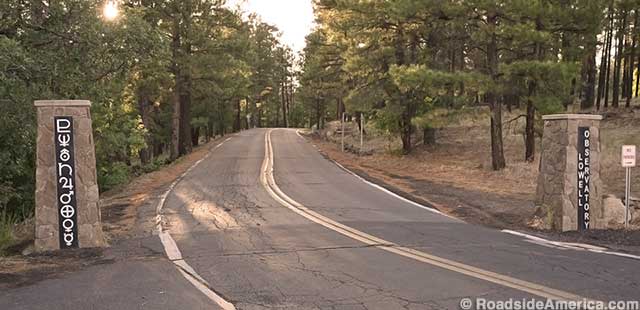
Observatory entrance: cryptic symbols are planetary shorthand, not Martian battle commands.
Lowell Observatory
Flagstaff, Arizona
The story of America's western expansion often evokes images of wagon trains and pioneer families seeking a better life. Or of solitary frontiersmen, seeking their fortune in the gold fields and pelt trade.
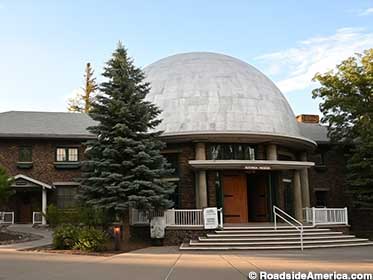
Rotunda Museum displays artifacts beneath a Saturn chandelier.
But once a railroad connected the coasts, people of means began trickling in, seeking a climate to cure their tuberculosis, or grand landscapes to photograph and paint.
And if you were Percival Lowell (1855-1916), scion of a prominent Boston family, sick of running a cotton mill and of taking clerical postings in Asia, you came west looking for Martians.
Lowell believed that there was intelligent life on the Angry Red Planet, a popular position at the turn of the 20th century, based on the findings of an an Italian astronomer who saw fuzzy canali (channels, but mistranslated into English as "canals") on the Martian surface. To prove this theory Lowell needed a better view of Mars, and for that he needed a place with clear air and dark night skies. A hilltop on the outskirts of Flagstaff -- pre-Route-66 and its neon signs -- proved ideal.
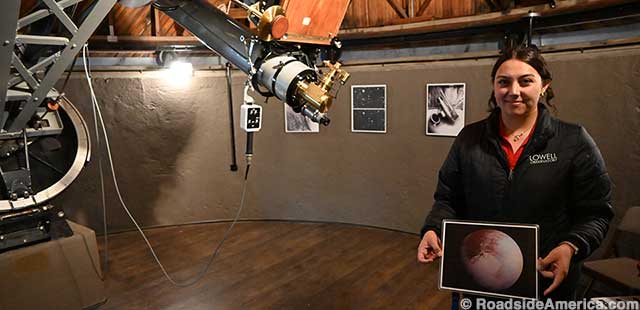
Staffer holds photo of Observatory's favorite planet: not Mars, but Pluto.
Lowell began his work in 1896 -- and Lowell Observatory is still there, still making astronomical observations, and welcoming visitors. But in its historical displays, Lowell's Martian concepts are kept to shallow summaries. You have to look hard to find any mention of extraterrestrial canals.
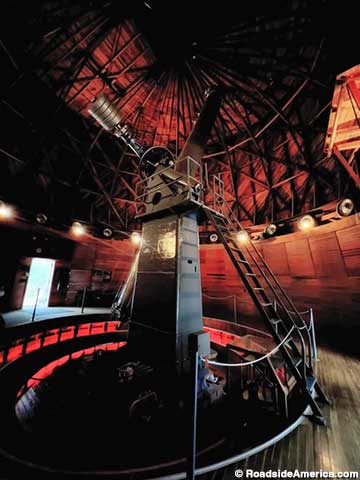
Lowell's 24-inch telescope. Automobile tires rotate the dome.
That's because, despite years of effort, Lowell never found any. Frustrated, he redirected his energies toward finding what he called "Planet X" -- what we know today as Pluto. Astronomy lore has it that Lowell worked himself to death in his hunt for Planet X, partly to reestablish his reputation after his Mars canal flop (Although, to be fair, his hypothesis was not definitively debunked until 1965, when Mariner 4 sent the first close-up canal-free photos of Mars).
Ironically, Pluto was discovered at Lowell Observatory -- but by another astronomer, 14 years after Lowell had died. Lowell had unknowingly photographed Pluto in 1915, but did not notice it among the thousands of other specks of light in the sky.
Today the short road leading from Route 66 up to Mars Hill (a name safely assumed to have been bestowed by Lowell) is flanked by two stone pillars, one inscribed "Lowell Observatory," the other with hieroglyphic lettering. This is not Lowell's attempt at a Martian Alphabet; it is the planet names in scientific shorthand, stacked in their order from the sun. This puts Pluto at the top of the celestial totem.
The Observatory -- still overseen by the Lowell family -- is proud of its role in Pluto's discovery. It hosts an annual "I Heart Pluto" festival, and the gift shop sells t-shirts emblazoned Still a Planet to Me and I Miss Pluto -- references to Pluto's 2006 demotion from planet to dwarf planet.
One of the Observatory's original buildings contains Percival's study, now the "Rotunda Museum." Its circular shape was designed as a tribute to Lowell's wife Constance's favorite planet, which was not Mars or Pluto, but Saturn (The room's chandelier sports the planet's familiar rings). Displayed here are memorabilia cataloging Pluto's life from the hypothetical Planet X to its 21st century degradation. Visitors can see the original telegram suggesting the name Pluto, and images from a peaceful demonstration in protest of Pluto's downgrade.
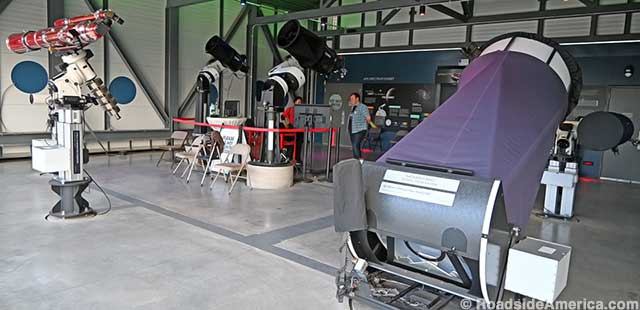
The Observatory provides modern equipment for visitors to study Flagstaff's night skies.
One of the oak display cabinets contains a photo of Lowell peering through one of his giant telescopes, wearing a three-piece suit and hat to ward off the cold in the unheated building (The image has been art-converted into the Observatory's logo). Here, too, are some of his logbooks, opened to pages filled with countless sketches of Mars' surface, with slight variations in each. No doubt Lowell thought that this methodical map-making would one day lead to confirmation of his canal theory, making his efforts, and considerable depletion of his family's largesse, worth it.
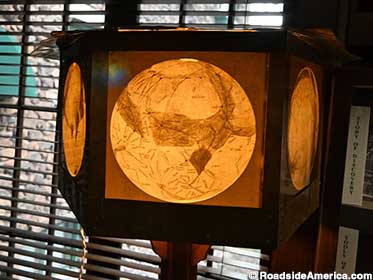
Lowell's maps of Mars canals.
Percival is entombed only a few hundred feet from the study, in the shadow cast by his largest observatory dome. He is the only Lowell not buried in the family's Massachusetts plot. His mausoleum resembles, and is probably mistaken for, yet another observatory dome, its glass ceiling bathing him for eternity in starlight.
While the historical telescopes at Lowell Observatory are no longer in use, a half-dozen others are available to the public further up the hill at the "open deck observatory." Human guides are there, too, offering support and a watchful eye. This is not just a marketing tease, as the grounds are open six nights a week until 11pm. Like the rest of Flagstaff (the world's first Dark Sky city), light is kept to a minimum, making the earth below hard to see, but helping with the gaze toward the heavens.
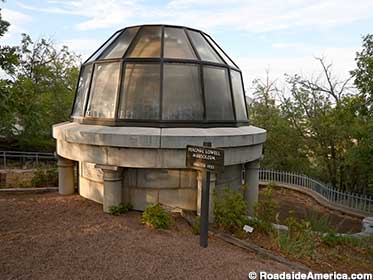
Percival Lowell is interred within his own mini-dome.
A path next to the open deck offers a chance for a contemplative walk through a wooded field populated with bronze busts of history's great scientific minds. Sir Isaac Newton, Copernicus... and, yes, Percival Lowell, all affixed at eye level on this undeveloped part of Mars Hill.
The "Pluto Discovery Dome" is up here as well, with the original equipment still in place. It looks as it did in 1930, when Clyde Tombaugh made his discovery, save for a few modern additions, such as a time capsule to be opened when an orbiter is sent to Pluto, and a boxing glove affixed to a jutting part of the telescope, which protects the heads of those who maintain it.
Lowell Observatory remains a monument to its maverick founder, even if it doesn't advocate his ideas. Having established itself as a real and dignified research facility, the Observatory doesn't want to shine too bright a light on its original purpose -- as a place to look for space aliens. That might attract a different sort of visitor, one who could possibly misuse the professional telescopes, or jimmy open locked doors.
The Pluto connection, however, is a safe appeal to those visitors more interested in people than in planets. No matter where you fall on its downgrade debate, at least it's based in real science, not a subpar grasp of the Italian language. And while Lowell's Saturn-loving widow Constance didn't get her wish to name Planet X "Lowell" or "Percival," his name is still on the buildings at Mars Hill.





